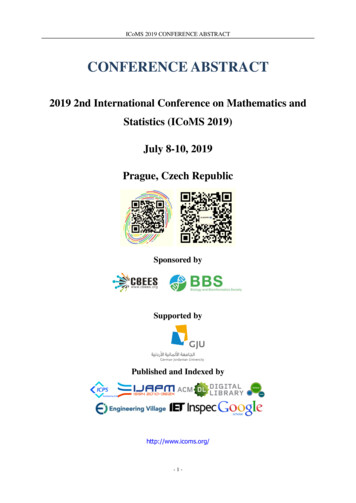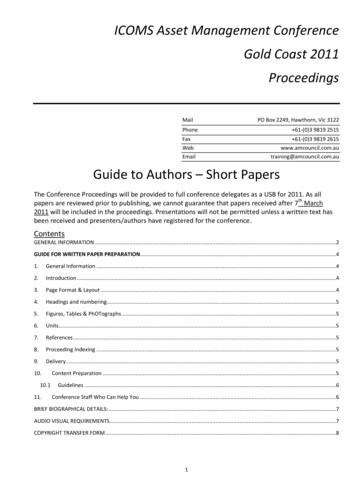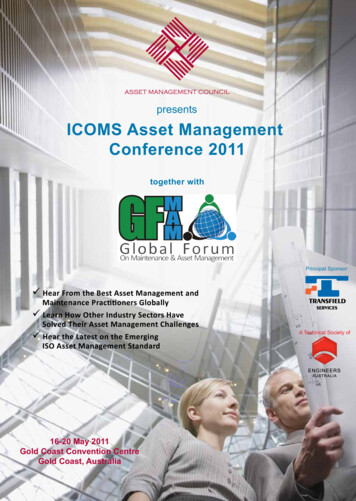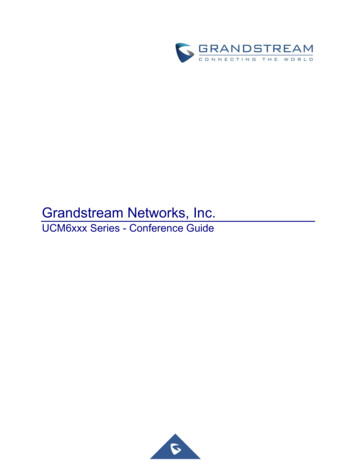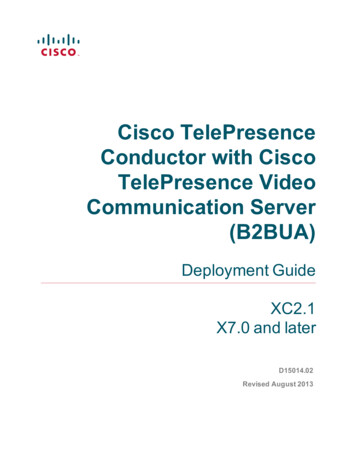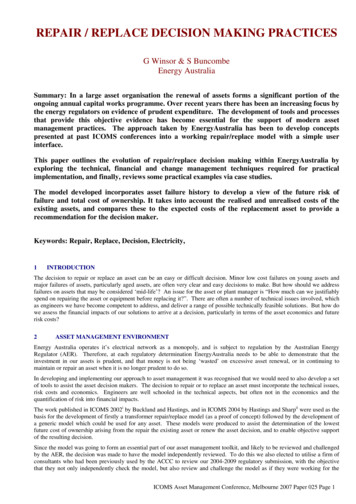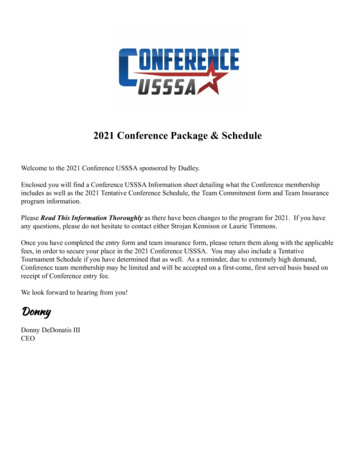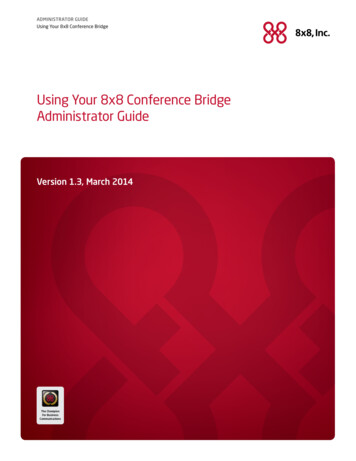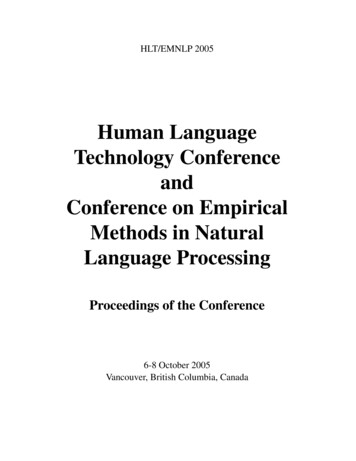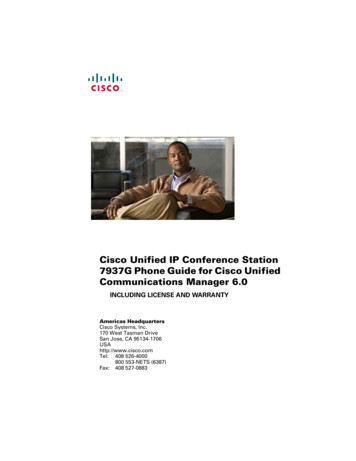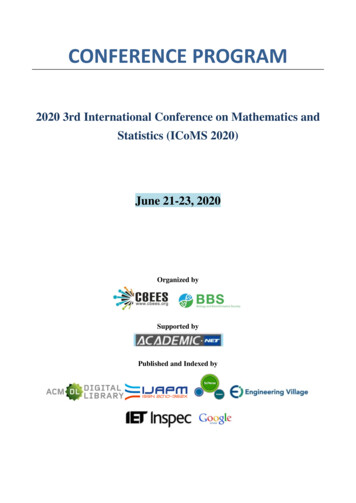
Transcription
CONFERENCE PROGRAM2020 3rd International Conference on Mathematics andStatistics (ICoMS 2020)June 21-23, 2020Organized bySupported byPublished and Indexed by
Table of Contents1. Conference Introduction32. Presentation Guideline43. ZOOM User Guideline64. Program-at-a-Glance74.1 Test Session Schedule74.2 Formal Session Schedule85. Conference Chair96. Keynote Speaker10-127. Invited Speaker13-148. Detailed Program for Oral Session8.1 Oral Session 1--Topic: “Pure Mathematics”15-168.2 Oral Session 2--Topic: “Applied Statistics”17-188.3 Oral Session 3--Topic: “Mathematical Modeling”19-208.4 Oral Session 4--Topic: “Data Mining and Analysis”21-222
Conference IntroductionWe welcome your participation and contribution to the 2020 3rd International Conference onMathematics and Statistics (ICoMS 2020) to be held online during June 21-23, 2020.ICoMS 2020 is organized to bring together worldwide leading researchers and practitionersinterested in advancing the state of the art in Mathematics and Statistics, for exchanging knowledgethat encompasses a broad range of disciplines among various distinct communities. It is hoped thatresearchers and practitioners will bring new prospects for collaboration across disciplines and gaininspiration to facilitate novel breakthroughs. The themes for this conference are thus focused on"Pure, Applied and Computation of Mathematics and Statistics".The annually held conference is expected to provide an opportunity for the researchers to meet anddiscuss the latest solutions, scientific results and methods in solving intriguing problems in the fieldsof Mathematics and Statistics. The conference programme will include prominent keynote speakers,invited speakers and regular paper presentations in parallel tracks. The General Chairs, along withthe entire team cordially appreciate you to submit your latest research results and to take part in theupcoming conference, to be held online during June 21-23, 2020.Papers will be published in the following proceeding or journal:All accepted papers fulfilling requirements on quality will be published in ACMInternational Conference Proceedings (ISBN: 978-1-4503-7541-2), and which willbe archived in ACM Digital Library, indexed by EI Compendex and SCOPUS.Selected excellent papers will be recommended to be reviewed for publication inInternational Journal of Applied Physics and Mathematics (IJAPM) (ISSN:2010-362X), and will be indexed by EI (INSPEC, IET), Index Copernicus, CAS, etc.Conference website and email: http://www.icoms.org; icoms@cbees.net3
Presentation GuidelinePresentation Requirement At least one author should present for each abstract/full paper during the session.Time Zone The time shown in this program is Greenwich Mean Time (GMT 02:00)–France LocalTime. Please set up your laptop time in advance.Equipment Needed A computer with an internet connection (wired connection recommended). USB plug-in headset with a microphone (recommended for optimal audio quality). Webcam (optional): built-in or USB plug-in.Environment Requirement Quiet Location. Stable Internet Connection. Proper lighting.Voice Control Rules during the Presentation The host will mute all participants while entering the meeting. The host will unmute the speakers' microphone when it is turn for his or her presentation. Q&A goes after each speaker, the participant can raise hand for questions, and the host willunmute the questioner. After Q&A, the host will mute all participants and welcome next speaker.Warm Tips for Oral Presentation Get your presentation PPT files prepared. Regular presentation is 20 minutes including 15 minutes of presentation and 5 minutes ofQ&A. To effectively control the time and avoid some unexpected situations, it is suggested thatyou should record your presentation ahead of time, do the live oral presentation online orplay the video while it's your turn for presentation.Step 1: Author records a video introduction with their own image, speaking to thecamera, introducing themselves: name, affiliation, brief description of scope of theirworkStep 2: Author then switches to their slides and provides a voiceover describing imagesin each slideStep 3: Authors need to be able to upload these presentations to a location specified byYOU in advance. Send the video to the staff in advance.4
Presentation GuidelineBest Presentation Award One Best Presentation will be selected from each session, and the result will be announcedat the end of the session.Conference Material All presented papers will be issued with soft copy of conference materials: Receipt,Participation and presentation certificate, etc.Notes Log in the meeting room 10 minutes ahead of the session. Learn the zoom skills. Please kindly keep your Paper ID in mind so that the staff can quickly locate yourregistration information. Your punctual arrival and active involvement in each session will be highly appreciated. The conference will be recorded; we will appreciate your proper behavior.Follow us Add the Wechat of CBEES-BBS for more detailed and updated conference news.Scanning me:5
ZOOM User GuidelineDownload the ZOOM: https://zoom.us/downloadLearn the ZOOM skills Please 1362033-Getting-Started-on-Windows-and-Mac GIF guideline: http://icoms.org/zoom.htmlHow to use ZOOM: Sign up an account.Set the language.Test computer or device audio.Join a meeting: Join the meeting with "meeting ID" provided in the program, tap the nameas "Paper ID-name", eg. " F0007-Freya Shi" or “Lis-Freya Shi”, then click "Join". Get familiar with the basic functions: Rename, Chat, Raise Hand, Start Video, Share thecomputer sound and Screen Share, etc.The most important function is Share Screen, because you will use it for your onlinepresentation.On June 21, we will have test session. On that day, we will teach you how to use ZOOM and thefunctions mentioned above. If you don’t know how to use, please do not worry. However, you mustdownload ZOOM, then, you can join the conference.6
Program-at-a-GlanceTest Session :3011:30-12:00EventMeeting IDTest Session 1-Topic: “Pure Mathematics”F0010, F2005, F2028, F2031, F2011Test Session 2-Topic: “Applied Statistics”F3002-A, F2009, F0005, F0006, F2003Test Session 3-Topic: “Mathematical Modeling”F0011, F0021, F0019, F0020, F1004Test Session 4-Topic: “Data Mining and Analysis”F0014, F0015, F2010, F0022, F0018639-9428-183412:00-14:00June 4014:40-14:50BreakKeynote Speaker IProf. Nikolaos Limnios, University of Technology ofCompiegne, FranceKeynote Speaker IIProf. Ding-Geng Chen, University of NorthCarolina-Chapel Hill, USAKeynote Speaker IIIProf. Alexander Bulinski, Moscow State University,RussiaInvited Speaker IProf. João Tiago Praça Nunes Mexia, UniversidadeNova de Lisboa, PortugalInvited Speaker IIAssoc. Prof. Nazrina Aziz, Universiti Utara Malaysia,Malaysia639-9428-1834Tips: Please log in the meeting room in the specific test session on time. Oral presentation test: 5 minutes/per paper.7
Program-at-a-GlanceFormal Session ScheduleDateDurationEvent13:40-14:00Join in the Meeting Room14:00-14:1014:10-14:5014:50-15:30June 22MondayOpening RemarksProf. João Tiago Praça Nunes Mexia, UniversidadeNova de Lisboa, PortugalKeynote Speech IProf. Nikolaos Limnios, University of Technology ofCompiegne, FranceKeynote Speech IIProf. Ding-Geng Chen, University of NorthCarolina-Chapel Hill, 40-17:00Meeting ID639-9428-1834BreakKeynote Speech IIIProf. Alexander Bulinski, Moscow State University,RussiaInvited Speaker IProf. João Tiago Praça Nunes Mexia, UniversidadeNova de Lisboa, PortugalInvited Speaker IIAssoc. Prof. Nazrina Aziz, Universiti Utara Malaysia,Malaysia639-9428-1834Back up Room for Q&A940-2336-5584Formal Session ScheduleDateJune 23TuesdayDurationEvent10:00-11:40Session 1-Topic: “Pure Mathematics”F0010, F2005, F2028, F2031, F2011Session 2-Topic: “Applied Statistics”F3002-A, F2009, F0005, F0006, F200311:40-13:00Break13:00-14:40Session 3-Topic: “Mathematical Modeling”F0011, F0021, F0019, F0020, F1004Session 4-Topic: “Data Mining and Analysis”F0014, F0015, F2010, F0022, F001810:00-14:40Back up Room for Q&A8Meeting 5584940-2336-5584
General ChairProf. Jochen MerkerLeipzig University, GermanyJochen Merker is professor of ”Analysis and Optimization” at the Leipzig University of AppliedSciences since 2015. He received his PhD in Mathematics from the University of Hamburg in 2005.Afterwards he worked as a Postdoc in ”Applied Analysis” at the University of Rostock, received hisHabilitation in 2012 and became a professor in Stralsund in 2013, before he became a full professor atHTWK Leipzig. His research focuses on PDEs and functional analysis, particularly functional analyticsettings for linear and nonlinear stationary and evolution equations, especially degenerate and singularparabolic PDEs with non-local terms, and on (contact) Hamiltonian systems on manifolds. Regardingthis topic, he received in 2018 a honorable mention in the international Ian Snook Prize 2017 for hisresearch article On local Lyapunov exponents of chaotic Hamiltonian systems, CMST 24(2) (2018),97–111. Since 2019 he is Advisory Editor of the prestigious journal ”Mathematical Methods in theApplied Sciences” (Wiley)9
Keynote Speaker IProf. Nikolaos LimniosUniversity of Technology of Compiegne, FranceNikolaos LIMNIOS is Professor of Exceptional class (PhD 1983 and Dr Sciences 1991) at Universityof Technology of Compiegne at Sorbonne University Alliance and former Director of the AppliedMathematics Lab., in Compiegne. His research interests include: Statistical Inference for StochasticProcesses, Stochastic Processes, Diffusion and Poisson Approximation, Semi-Markov and Hiddensemi-Markov Processes, Random Evolutions, Branching Processes, with applications in Reliability,Biostatistics, Seismology, Insurance and Finance. He published about 150 journal papers and 10monographs. He is an Associated Editor of the journals: Communications in Statistics: Theory andMethods, Communications in Statistics: Simulation and Computation, Methodology and Computing inApplied Probability, Journal of Statistical Theory and Practice, Reliability: Theory and Applications(Electronic journal). He is the Editor-in-Chief of books series "Mathematics and Statistics", iSTE,London, (published with J. Wiley, Elsevier).Speech Title: "Semi-Markov Chains and Estimation of their Stationary Distribution"Abstract—Our presentation concerns semi-Markov processes in discrete-time. Semi-Markov chainsgeneralise the Markov chains and renewal processes in discrete-time. These kind of processes are usedin many different applications: in biology for the sequences of DNA, RNA, in survival analysis, inearthquake studies, in cracking in mechanics, in information theory, in reliability, etc. One of the maincharacteristics of these processes is their stationary distribution. We propose an empirical estimator ofthe stationary distribution based on the evolution of the semi-Markov system in a time interval. Basicproperties and estimation problems of stationary distribution function. We will present approximationresults in a functional setting and then we will them to obtain estimators properties, as consistency andasymptotic normality.10
Keynote Speaker IIASA Fellow, Prof. Ding-Geng ChenUniversity of North Carolina-Chapel Hill, USADr. (Din) Ding-Geng Chen is the Wallace H. Kuralt distinguished professor at the School of SocialWork and a professor in biostatistics at the Department of Biostatistics at Gillings School of GlobalPublic Health from the University of North Carolina-Chapel Hill, USA. Before this, he was a professorin biostatistics at the University of Rochester Medical Center, the Karl E. Peace endowed eminentscholar chair and professor in biostatistics from the Jiann-Ping Hsu College of Public Health at theGeorgia Southern University. Dr. Chen is an elected fellow of American Statistical Association (ASA),an elected member of the International Statistics Institute (ISI) and a senior expert consultant forbiopharmaceuticals and government agencies with extensive expertise in clinical trial biostatistics. Hehas more than 200 professional publications and co-authored/co-edited 30 books on biostatistics clinicaltrials, biopharmaceutical statistics, interval-censored survival data analysis, meta-analysis, public healthstatistics, statistical causal inferences, statistical methods in big-data sciences and Monte-Carlosimulation based statistical modeling. He has been invited internationally to speak and give shortcourses and tutorials at various scientific conferences.Speech Title: "Data Fusion and Statistical Meta-Analysis in Big-Data Era"Abstract—Data fusion and statistical meta-analysis is a process of integrating multiple data sources anddiverse studies to produce more reliable and efficient conclusion. In this big-data era, it is natural, ratherthan the exception, that the data collected to address the same/similar scientific question come fromdiverse sources. The art and science of synthesizing information from diverse sources to draw a moreeffective inference is generally referred to as systematic reviews and meta-analysis It can be performedby either synthesizing study-level summary statistics (SS) or modeling individual participant-level data(IPD), if available. However, it remains not fully understood whether the use of IPD indeed gainsadditional efficiency over SS. In this talk, we discuss the relative efficiency of the two methods under ageneral likelihood inference setting. We show theoretically that there is no gain of efficiencyasymptotically by analyzing IPD, provided that the random-effects follow the Gaussian distribution andmaximum likelihood estimation is used to obtain summary statistics. Our findings are confirmed bysimulation studies and a real data analysis of beta-blocker treatment effect for myocardial infarction.This is a joint work among Drs. Dungang Liu, Xiaoyi Min and Heping Zhang, paper published atBiometrics (Chen, D.G, Liu, D., Min, X. and Zhang H. Relative efficiency of using summary /biom.13238).11
Keynote Speaker IIIProf. Alexander BulinskiMoscow State University, RussiaAlexander Bulinski, Professor of the Moscow State University, Dr. Sc. Phys. Math. (Habilitation) is aMember of the Board of the Moscow Mathematical Society since 2000, was a Member of theEuropean Committee of the Bernoulli Society (2002-2006). He is an author of 5 books and numerousresearch papers. His main results pertain to the theory of stochastic processes and random fields.Various statistical applications of limit theorems are also in the scope of his activity. A.Bulinskibelongs to the scientific school of Professor A.N.Kolmogorov being his former PhD student. He wasawarded the State Scholarship for prominent scientists and International Science Foundation Diploma for outstanding contribution to world science and education''. He is a winner of the Lomonosovprize in Science. A.Bulinski is a Member of the Editorial Boards of 6 journals. He was InvitedProfessor in France, Germany, Sweden, Netherlands, UK etc. Under his scientific direction 15PhD-theses were written and 4 are in preparation. He was Keynote Speaker and Invited Speaker, aswell as a member of Program Committees, at various International conferences. A.Bulinski is aMember of the Expert Council for Higher Qualification Committee of Russia, Head of the FederalTeaching Union on Mathematics and Mechanics in the Higher Education System of Russia.Speech Title: "Feature Selection Theory and Applications"Abstract—The talk is devoted to study of stochastic models described by means of some featurescollection X (X1; : : : ;Xn) and a response variable Y: Such models are widely used, e.g.,inmedicine and biology, where Y can characterize the health state of a patient and X comprisesgenetic and nongenetic factors. We are interested in models involving high-dimensional observations.A challenging problem is to identify the sub-collection of in uential (in a sense) factors. There arewell-known feature selection procedures. Here we mention only few of them: Booleanoperation-based screening and testing (BOOST), least absolute shrinkage and selection method(LASSO), adaptive and group LASSO, nonnegative (NN) Garrote, penalized regression withsmoothly clipped absolute deviation (SCAD) penalty, least angle regression (LAR) and generalizedDantzig selector (DS). Traditionally feature selection methods are classi ed into lters, wrappers andembedded ones. The hybrid methods are also treated. An important subject is the development ofalgorithms for structured features (e.g., having group or tree, or graph structure). Usually oneassumes that all features are known in advance. However, in certain models the candidate features aregenerated dynamically, thus the size of features is unknown. Such features are named streaming onesand a streaming feature selection arises. Feature selection methods give a possibility to improve theprediction performance, to reduce the computation time and better understand the structure of thedata. This research domain is located at the border of the modern statistics and machine learning.Along with a survey we concentrate on the new results involving various concepts of informationtheory. Among tools we mention the transfer entropy and the Kull-back - Leibler divergence.Appropriate theorems are provided to describe the asymptotic properties of statistics underconsideration. Cross-validation and stability problems (including the choice of di erent stabilitymeasures) are in the scope as well. Special attention is paid to applications in bioinformatics, namely,in genome-wide association studies (GWAS). We tackle also the simulation problems related tofeature selection.12
Invited Speaker IProf. João Tiago Praça Nunes MexiaUniversidade Nova de Lisboa, PortugalProf. João Tiago Praça Nunes Mexia was born in Lisbon in June of 1939. The most part of his careerwas as Full Professor at the FCT/UNL-Faculty for Sciences and Technology of the New Universityof Lisbon. At that time he supervised the teaching of Statistics at FCT/UNL and directed theResearch Center in Mathematics of the University (CMA-Center for Mathematics and itsApplications) from 1999 to 2009. In 2009 he became Emeritus Professor. Until now he supervised 19Ph.D. and co-supervised 12 Ph.D. His research is centered on Linear Statistical Inference, havingalmost 100 papers published in International Journals.Topic: “Additive Models: Estimation, Prediction and Structured Families”Abstract—We generalize the classic Scheffe Theorem, that will be applied to normal vectors withcovariance matrix δ2C; known up to δ2; independent from S; being S the product by δ2 of a centralchi-square. Namely, C may be not invertible. We obtain confidence ellipsoids and simultaneousconfidence in-tervals, through duality. These confidence intervals will be used to "refine" F tests forfixed effects models. The asymptotic version of these results will be obtained using the continuousmapping theorem. Lastly we consider the case of the singular multinomial distribution.13
Invited Speaker IIAssoc. Prof. Nazrina AzizUniversiti Utara Malaysia, MalaysiaNazrina Aziz is currently Associate Professor of Statistics in the Department of Mathematics andStatistics at the Universiti Utara Malaysia. She has taught a vast range of statistics courses forundergraduate degrees, master’s degrees and training courses. Her research interest concerns theinvestigation of theoretical problems and applications in a variety of areas such as AcceptanceSampling, Satisfaction Survey, Program Evaluation Survey, Disease Mapping and StatisticalModeling in Healthcare. She has involved in developing a few instruments to measure industrialemployees’ and tertiary education’s satisfaction. She has also edited three books, four scopus indexedproceedings and contributed five chapters in different books. Currently, a majority of herpostgraduate students are investigating on acceptance sampling. Most of their works have beenpublished in indexing journals and proceedings.Title: New Group Chain Sampling Plan (NGChSP-1) for Generalized Exponential DistributionAbstract—Recently, many researchers have developed various acceptance sampling plans to be usedby producers in making decision whether to accept or reject inspected lots. In 2015, Mughal, Zainand Aziz proposed group chain sampling plan (GChSP) that solves the issues in chain acceptancesampling plans (ChSP) (time complexity during inspection) and group acceptance sampling plans(GSP) (insecure probability of lot acceptance). GChSP was created based on three acceptance criteria,the first being no defective is recorded in the current lot - without considering the number ofdefectives found in preceding lot. This contradicts with the condition of having a cumulative of onedefective for the current lot to be accepted. Hence, in this article we developed the new group chainsampling plan (NGChSP-1) to handle the issue of acceptance criteria in GChSP. The NGChSP-1 isdeveloped based on truncated life test for generalized exponential distribution. The performancecomparison of the NGChSP-1 and GChSP are discussed in the findings.14
Detailed Program for Oral SessionSession 1: Pure MathematicsTime: 10:00-11:40, June 23, 2020 (Tuesday)Greenwich Mean Time (GMT 02:00) – France Local TimeMeeting ID: 639-9428-1834Session Chair: Dr. Sandra Ferreira, New University of Lisbon, istence of the Solution for the Problem in Subdi usive Medium with aMoving Concentrated SourceHon-hung Terence LiuTatung University, TaiwanAbstract—This paper investigates the problem of a fractional differentialequation with moving concentrated source in an infinite rod. Thisfractional differential operator is used to formulate the diffusion problemin a subdiffusive medium. The existence of the solution is established, thefinite time blow-up criteria for the solution of the problem is given. Thecritical speed of the concentrated sources on the behavior of the solutionare investigated. keywords. Green's function, fractional diffusionequations, fractional derivatives, moving concentrated source AMS(MOS) Subject Classification. 35R11, 35R12.Metrics for Multi-Set-Theoretic Graphs over Fixed Set of VerticesRay-Ming ChenBaise University, ChinaAbstract—In this article, we show how to define distance functions formultiedged graphs, either with vertices being labelled or unlabelled.These metrics are constructed mainly based on the minimal matching formulti-sets. In the end, we implement such metrics based on adjacentmatrices. These metrics provide some important applications in the A Note on Integrating Factors of a Conformable Fractional DifferentialEquationF. Martínez, I. Martínez and S. ParedesUniversidad Politécnica de Cartagena, SpainAbstract—Recently exact fractional differential equations have beenintroduced, using the conformable fractional derivative. In this paper, wepropose and prove some new results on the integrating factor. Weintroduce a conformable version of several classical special cases forwhich the integrating factor can be determined. Specifically, the cases wewill consider are where there is an integrating factor that is a function ofonly x, or a function of only y, or a simple formula ofand . Inaddition, using the Conformable Euler's Theorem on homogeneousfunctions, an integration factor for the conformable homogeneousdifferential equations is established. Finally, the above results apply insome interesting examples.A Knot Selection Algorithm for Splines in Logistic RegressionTzee-Ming HuangNational Chengchi University, Taiwan15
Detailed Program for Oral SessionS1-5F201111:20-11:40Abstract—In ordinary logistic regression, the logit of the conditionalprobability of the response given the covariates is modeled as a linearfunction of the covariates. In this study, a more general logistic regressionmodel is considered, where linearity is not assumed. Since the linearfunction of the covariates is replaced by a general function of thecovariates, spline approximation is used. A knot selection algorithm isproposed to determine the knot locations in spline approximation.Simulation experiments have been carried out to check the performanceof the proposed algorithm. The proposed algorithm performs reasonablywell.On the Construction of Multivariate correlation CoefficientsJochen Merker and Gregor SchuldtLeipzig University of Applied Sciences, GermanyAbstract—A multivariate (un)correlation coefficient maps a vector-valuedrandom variableto a real number between 0 and 1,which indicates how linearly (un)correlated its componentsare. In this paper, we provide a unified framework formultivariate (un)correlation coefficients known in literature, and constructnew multivariate (un)correlation coefficients using Rényi entropies,which allow applications in many scientific areas.16
Detailed Program for Oral SessionSession 2: Applied StatisticsTime: 10:00-11:40, June 23, 2020 (Tuesday)Greenwich Mean Time (GMT 02:00) – France Local TimeMeeting ID: 940-2336-5584Session Chair: Assoc. Prof. Nazrina Aziz, Universiti Utara Malaysia, 0:40F000510:40-11:00Auxiliary Information for Improving the Statistical Matching of Incomeand ConsumptionIrene Rioboo and Friderike OehlerEuropean Commission, LuxembourgAbstract—This exercise addresses the joint distribution of income andconsumption produced through a statistical matching of the EuropeanStatistics on Income and Living Conditions (EU-SILC) and theHousehold Budget Survey (HBS). The major limitation of the methodsgenerally used in statistical matching is that they are based on theConditional Independence Assumption (CIA), which is very strict, seldomholds and is difficult to test with the data available. In order to relax oravoid this assumption we test two alternatives. The first option uses asmatching variable a proxy of the EU-SILC target variable. The highcorrelation between those variables allows considering the CIA aplausible hypothesis. The second option avoids the CIA by using a thirdsource where income and consumption are jointly observed: the moduleon Over-indebtedness, Consumption and Wealth (OWC) of the 2017EU-SILC wave. This exercise compares both options and their role inimproving the estimates provided by the statistical matching.Estimating of Factors Influencing the Brewing Market by Using DecisionTrees: A Case of BulgariaHristina Kulina, Snezhana Gocheva-Ilieva and Atanas IvanovUniversity of Plovdiv Paisii Hilendarski, BulgariaAbstract—This study examines the influence of key market factors –price, distribution, digital and non-digital advertising, atmospherictemperature and others on the sales of the brewing sector in Bulgaria. Themonthly observations over nearly five years are analyzed for a majorbrand of beer. The data are modeled using the powerful data miningtechnique of Classification and Regression Trees (CART). The builtmodels describe beer sales in relation to the studied factors with highgoodness-of-fit statistics: coefficient of determination up to R2 94% andRMSE 3.11. Cross-validation and holdout data sampling are used toassess the quality of obtained models. The models are applied forforecasting the volume of beer sales for one month ahead.Assessing the Risk of Cancer Prevalence from Lifestyle Activities amongStudents I n Bloemfontein, South AfricaG. Makanda, R. Sypkens and M.S MakandaCentral University of Technology, South AfricaAbstract—The prevalence of cancer and cardiovascular diseases hascaused one of the highest death rates in the world. Research has shown17
Detailed Program for Oral t lifestyle is the major cause of cancers. Cancerous cells develop duewhat people eat and how they live their lives. This research investigatesthe risk of cancer occurrence in Bloemfontein in South Africa. Theresearch was carried out by using a questionnaire developed by CANSASouth Africa on this assessment. The questionnaire included variouslifestyle questions. The data was then analyzed using SPSS and EvaSys(Automated Evaluation Software). The results show that most people donot eat healthy and thereby having a high risk of developing cancers.Machine Learning Versus Statistical Methods in Demand Planning forEnergy-efficient Supply ChainsLucas Schreiber and Nikolas MoroffFraunhofer Institute for Material Flow and Logistics, GermanyAbstract—The research project "E²-Design" intends to integrate energyefficiency as a planning parameter in the design of production andlogistics networks. In order to achieve this objective, models and methodsare developed that enable an appropriate approach in the strategic andtactical planning of supply chains. It was observed that models andmethods for designing supply chains are always based on accuratedemand forecasting. This is equally true for the design of supply chainswith the core objective of energy efficiency. The better and more granularthe demand forecast can be performed, the more valid recommendationsfor action can be provided to improve energy efficiency. To accomplishthis, this paper aims at identifying promising models for the selection andimplementation of a demand forecasting algorithm. By an initialcomparison of statistical methods with machine learning methods, highpotentials in the context of machine learning will be identified.Subsequently, several process models for implementing a suitablemachine learning algorithm
ICoMS 2020 is organized to bring together worldwide leading researchers and practitioners interested in advancing the state of the art in Mathematics and Statistics, for exchanging knowledge . the stationary distribution based on the evolution of the semi-Markov system in a time interval. Basic properties and estimation problems of stationary .
